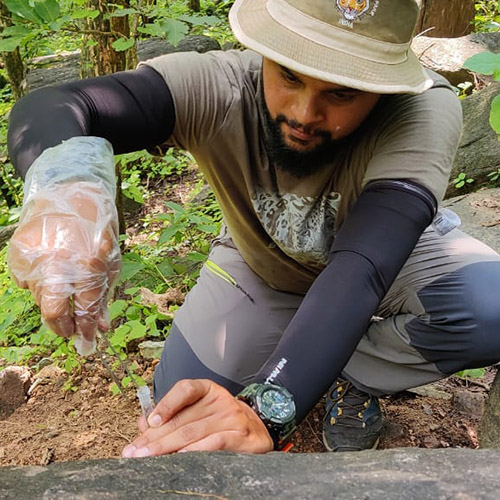FNR Field Report: Katie Buckles
Students from Purdue Forestry and Natural Resources took their classroom knowledge to the field for summer internships and paid positions across the country, gaining valuable experience, hands-on training and career guidance. The FNR Field Reports series offers updates from those individuals as their positions draw to a close.
Katie Buckles, a senior wildlife major minoring in aquatic sciences, worked as a technician at the Purdue Aquaculture Research Lab and as a lab tech in Dr. Tomas Hook’s Freshwater Ecology Lab this summer.
At ARL, her responsibilities included fish feeding, water quality management, harvesting and selling fish and organizing the lab and equipment. The Lafayette, Indiana, native’s main projects included rearing walleye and largemouth bass fingerlings.
In the Freshwater Ecology Lab, Buckles helped collect data for research projects, completed zooplankton identification and counting, fish dissection, water quality management and feedings.
“I have learned a lot working these two jobs,” Buckles said. “My ARL job has taught me a lot about aquaculture. Before the job I had no knowledge of aquaculture but was interested in it. After working there for about 1.5 years, I have learned how to take care of certain fish species, water quality parameters, how different aquaculture systems work, and how to sample fish. After working for the Freshwater Ecology Lab, I have learned how to identify multiple species of zooplankton and how to perform different water quality tests. From both jobs, I have learned how to be flexible with the tasks given. I also adapted to be quick to learn new tasks and then be able to correctly do those tasks on my own.”
The hands-on experience of working with the various fish species at the ARL is Katie’s favorite part of that position. In the Hook Lab, she enjoyed learning new things, such as the different species of zooplankton, and also meeting other lab technicians.
Both roles forced Katie out of her comfort zone.
“The most challenging part for both jobs for me personally was asking questions,” Katie shared. “It is crucial to ask questions in those lab technician jobs. As a person who does not like asking questions, it forced me to ask questions when I did not understand something. This challenge has helped me be more open in learning more about the tasks that I am given.”
Classes in her aquatic sciences minor, including a course where she learned the meaning of water quality parameters, assisted her in successfully performing both jobs. Buckles also noted that her previous FNR courses required her to be very detail-oriented, which she was able to apply in both roles.
Her past experience conducting undergraduate research under Dr. Hook also helped prepare Katie for the summer positions. Her research compares the growth rates and diets of larval yellow perch between different lake habitats (Lake Michigan and drown river mouth lakes).
Having worked in the Aquaculture Research Lab setting for more than a year has allowed Buckles to see the results of her previous efforts.
“An experience that stood out to me from my job at the ARL was sampling one of our recreational ponds,” Katie explained. “We sampled the pond using hook and line technique. The fish we sampled were largemouth bass that we grew last summer (2023). It was cool to see how much those bass grew within a year and that made me even more interested in learning more about fish and aquaculture in general.”
Katie said her summer experiences have changed her career goals and plans for the future.
“When coming into the Wildlife major, I thought I wanted to work with wildlife, but these jobs made me want to work in the aquatic setting instead,” Buckles noted. “Coming into the major, I thought I would want to work with mammals and bird management and conservation for a career. However, after my job at the ARL and the Freshwater Ecology Lab and after conducting my own research, I realized my interests have shifted. I realized that I want my career to be in managing or conservation of aquatic environments and species.”
 A collage of images from Katie Buckles' aquatic sciences work. Top row (Left to right): Identifying zooplankton in the Freshwater Ecology Lab; Identifying and counting water fleas under a microscope in the Freshwater Ecology Lab; Images of larval yellow perch from Katie's undergraduate research. Row 2: A fry counter that is used to count walleye fry. This is the beginning of the process of raising walleye. Katie says it is cool to watch them grow over the months; a walleye under a microscope at ARL. Katie was checking to make sure the walleye developed swimbladders to ensure they were ready for feeding; grading walleye to separate the small ones from the larger ones. Grading allows researchers to adjust their feedings based on their size; a largemouth bass Katie caught from the hook-and-line sampling she did. This bass was year one of the two-year bass study.
A collage of images from Katie Buckles' aquatic sciences work. Top row (Left to right): Identifying zooplankton in the Freshwater Ecology Lab; Identifying and counting water fleas under a microscope in the Freshwater Ecology Lab; Images of larval yellow perch from Katie's undergraduate research. Row 2: A fry counter that is used to count walleye fry. This is the beginning of the process of raising walleye. Katie says it is cool to watch them grow over the months; a walleye under a microscope at ARL. Katie was checking to make sure the walleye developed swimbladders to ensure they were ready for feeding; grading walleye to separate the small ones from the larger ones. Grading allows researchers to adjust their feedings based on their size; a largemouth bass Katie caught from the hook-and-line sampling she did. This bass was year one of the two-year bass study. 




